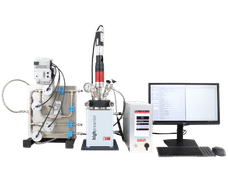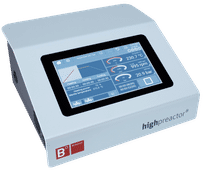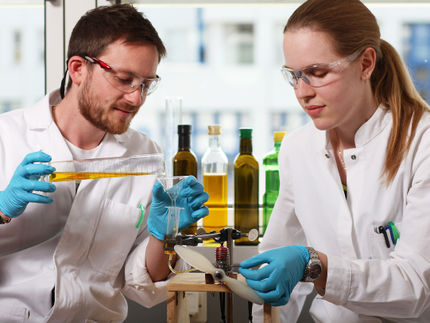Biofuel chemistry more complex than petroleum, say Sandia and Lawrence Livermore researchers
Understanding the key elements of biofuel combustion is an important step toward insightful selection of next-generation alternative fuels.
And that's exactly what researchers at Sandia and Lawrence Livermore national laboratories are doing.
The journal Angewandte Chemie devotes its May 10 cover to a paper co-authored by Sandia's Nils Hansen and Lawrence Livermore's Charles Westbrook, which examines the essential elements of biofuel combustion.
The paper, "Biofuel combustion chemistry: from ethanol to biodiesel," examines the combustion chemistry of compounds that constitute typical biofuels, including alcohols, ethers and esters.
Biofuels, such as ethanol, biobutanol and biodiesel, are of increasing interest as alternatives to petroleum-based transportation fuels. According to Hansen and Westbrook, however, little research has been done on the vastly diverse and complex chemical reaction networks of biofuel combustion.
In general, the term biofuel is associated with only a few select chemical compounds, especially ethanol (used exclusively as a gasoline replacement in spark-ignition engines) and very large methyl esters in biodiesel (used as a diesel fuel replacement in diesel engines). The biofuels are oxygenated fuels, which distinguishes them from hydrocarbons in conventional petroleum-based fuels.
While much discussion surrounding biofuels has emphasized the process to make these alternative fuels and fuel additives, Hansen and Westbrook are the first to examine the characteristic aspects of the chemical pathways in the combustion of potential biofuels.
In collaboration with an international research team representing Germany, China and the U.S., Westbrook, Hansen and former Sandia post-doctoral student Tina Kasper used a combination of laser spectroscopy, mass spectrometry and flame chemistry modeling to explore the decomposition and oxidation mechanisms of certain biofuels and the formation of harmful or toxic emissions. Hansen's experiments were conducted in part at the Chemical Dynamics Beamline of the Advanced Light Source at the Lawrence Berkeley National Laboratory.
To understand the associated combustion reactions and to identify recurring reaction patterns, Hansen and Westbrook agreed, it is important to study prototypical variants of potential biofuels.
Most read news
Other news from the department science
These products might interest you
 New
New
Fully automated hydrogenation reactor BR/H2 by Berghof
Fully automated hydrogenation reactor: Precise and safe hydrogenation at the flick of a switch
Optimised process control with leakage tests, gas consumption measurement and modular expandability

BRC - Berghof Reactor Controller by Berghof
BRC - complete package for data acquisition, storage and control of all process parameters
Touch controllers are easy to use and provide quick access to all important functions

Berghof Reaktortechnologie - Hoch- und Niederdruckreaktoren, Druckbehälter und metallfreie Reaktoren by Berghof
Safe high- and low-pressure systems for aggressive media
Corrosion-resistant reactors with PTFE lining - individually configurable

Get the chemical industry in your inbox
By submitting this form you agree that LUMITOS AG will send you the newsletter(s) selected above by email. Your data will not be passed on to third parties. Your data will be stored and processed in accordance with our data protection regulations. LUMITOS may contact you by email for the purpose of advertising or market and opinion surveys. You can revoke your consent at any time without giving reasons to LUMITOS AG, Ernst-Augustin-Str. 2, 12489 Berlin, Germany or by e-mail at revoke@lumitos.com with effect for the future. In addition, each email contains a link to unsubscribe from the corresponding newsletter.
Most read news
More news from our other portals
See the theme worlds for related content
Topic World Spectroscopy
Investigation with spectroscopy gives us unique insights into the composition and structure of materials. From UV-Vis spectroscopy to infrared and Raman spectroscopy to fluorescence and atomic absorption spectroscopy, spectroscopy offers us a wide range of analytical techniques to precisely characterize substances. Immerse yourself in the fascinating world of spectroscopy!

Topic World Spectroscopy
Investigation with spectroscopy gives us unique insights into the composition and structure of materials. From UV-Vis spectroscopy to infrared and Raman spectroscopy to fluorescence and atomic absorption spectroscopy, spectroscopy offers us a wide range of analytical techniques to precisely characterize substances. Immerse yourself in the fascinating world of spectroscopy!
Topic World Mass Spectrometry
Mass spectrometry enables us to detect and identify molecules and reveal their structure. Whether in chemistry, biochemistry or forensics - mass spectrometry opens up unexpected insights into the composition of our world. Immerse yourself in the fascinating world of mass spectrometry!

Topic World Mass Spectrometry
Mass spectrometry enables us to detect and identify molecules and reveal their structure. Whether in chemistry, biochemistry or forensics - mass spectrometry opens up unexpected insights into the composition of our world. Immerse yourself in the fascinating world of mass spectrometry!



























































